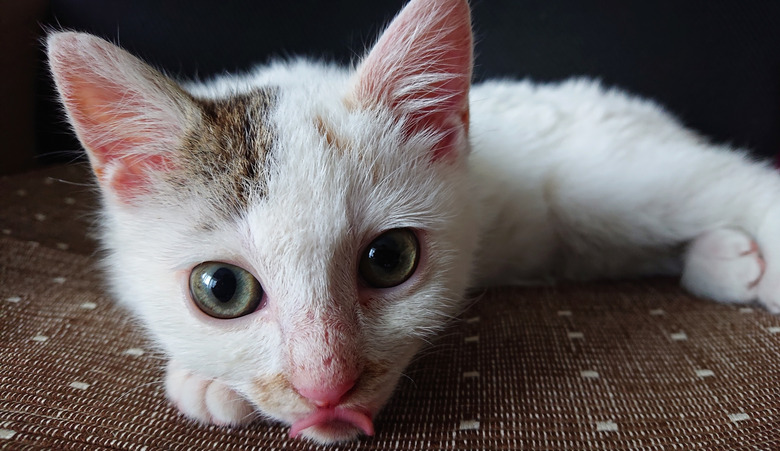Common Types Of Cancers In Cats
Like people, our feline companions can develop many types of cancers. It's estimated that 30 to 40% of cats are affected. Sometimes cats develop cancer because of genetics, breed, or aging. In general, older cats are more prone but young cats can also be affected. Certain feline cancers have also been linked with viruses like feline leukemia virus (FeLV) and feline immunodeficiency virus (FIV.)
Common signs of cancer in cats
Common signs of cancer in cats
Symptoms can vary and they can mimic signs of other diseases. General symptoms to watch for include:
- Weight loss
- Appetite loss
- Difficulty eating
- Bad breath
- Difficulty breathing or changes in how your cat breathes
- Vomiting and/or diarrhea, especially if it's persistent
- Lethargy
- Bleeding (e.g. nose, mouth, skin, gastrointestinal)
- A sore that doesn't heal, or seems to heal but then returns
- A lump or growth of any sort
- Enlarged lymph nodes (sometimes mistaken by pet owners for lumps)
- Lameness
Cancer and feline viral infections
Viruses aren't typically the first thing that pops into a person's mind when they hear the word "cancer" but there is a correlation in feline health. The two most significant viruses are FeLV and FIV. (In rare instances, cats with FeLV can also have feline sarcoma virus or FeSV. FeSV is a hybrid of FeLV and it forms in an FeLV-infected cat's body.)
There are several ways that some feline viruses cause cancer. They can compromise a cat's immune system, create chronic inflammation, disrupt a cat's genetic material or activate cancer genes. Cats infected with FeLV (and to a lesser extent, FIV) are more at risk for lymphoma. FIV-infected cats are also at increased risk for oral cancer.
Despite the name, most sarcomas in cats are not due to feline sarcoma virus. For example, only 2% of feline fibrosarcoma cases are caused by it. And when FeSV is the cause, these cats tend to be young. Young, FeLV-infected cats are also more likely to develop the mediastinal form of lymphoma.
How common is lymphoma in cats?
How common is lymphoma in cats?
Lymphoma is the most common cancer in cats, accounting for about 30% of feline tumors. It's a cancer of the lymphocyte (a type of white blood cell) and the lymphatic system (or lymphoid system.) Lymphocytes and lymphoid tissue are found throughout the body such as the gastrointestinal tract, lymph nodes, bone marrow and spleen.
There are various types of feline lymphoma, with the most frequently diagnosed being gastrointestinal, renal (kidney,) and mediastinal (an area within the chest) but other parts of the body can also be affected. Older cats and cats with FeLV (and to a lesser extent, FIV) are more likely to develop lymphoma. However, the mediastinal form is often seen in young cats.
Where does squamous cell carcinoma (SCC) happen in cats?
Where does squamous cell carcinoma (SCC) happen in cats?
This type of cancer can show up in a cat's mouth or on their skin. The form that appears in the mouth is the most common oral cancer in cats. It causes ulcers and can be mistaken for signs of dental disease.
Cats with lighter fur color are more at risk for the skin cancer form of SCC, as are cats who spend a lot of time in the sun. This type of cancer often shows up on the temples, tips of the ears, eyelids, nose and lips. It usually starts off looking like a scab or sore that might appear to heal. But eventually, the area develops an ulcer.
How common are mammary tumors in cats?
How common are mammary tumors in cats?
Known as adenocarcinoma, mammary tumors are the third most common cancer in cats. Feline mammary gland tumors, or breast tumors, are almost always malignant. This cancer is aggressive and the majority of affected cats experience metastasis to other parts of their body.
Middle-age and older female cats are more likely to develop mammary adenocarcinoma. Siamese cats are twice as likely than other breeds to develop it and they're more prone to getting cancer in general at a younger age.
Spaying your cat early dramatically reduces the risk. Cats spayed before 6 months of age have a 91% reduction in risk and cats spayed before the age of 1 year have an 86% reduction in risk.
Fibrosarcoma in cats
Fibrosarcoma in cats
This type of cancer originates from soft tissue like skin, muscle, connective tissue and blood vessels. Fibrosarcomas have been reported to develop at injection sites, such as from certain vaccinations, long-acting antibiotics, long-acting steroids and microchips.
Other potential causes are a foreign body or, less likely, from the feline sarcoma virus. Fibrosarcomas can also develop in the mouth.
Less common feline cancers: multiple myeloma and osteosarcoma
Less common feline cancers: multiple myeloma and osteosarcoma
Multiple myeloma is a cancer of the blood marrow and is rare in cats. It accounts for less than 1% of feline cancer cases. Dogs and people are more likely to develop this condition.
Feline osteosarcoma is also rare but common in dogs. However, when a cat does develop a bone tumor, there's a 70% chance it will be osteosarcoma.
Diagnosing cancer in cats
Diagnosing cancer in cats
Cancer diagnosis starts with a physical exam and a medical history. From there, a variety of tests are usually performed. They include but are not limited to:
- Blood work: complete blood count, chemistry, urinalysis, FeLV test, FIV test. Cats who are 7 years and older should have routine lab work done once a year.
- Radiographs (X-rays) ultrasound, CT and / or MRI
- Fine needle aspirate (FNA): this is a way to gather cells from lumps and certain internal organs. Sometimes an FNA can be diagnostic for cancer cells and sometimes it's inconclusive.
- Biopsy: this may be done if an FNA was inconclusive or if an FNA isn't possible for some reason.
- Histopathology: biopsies and some FNAs are sent to the lab for microscopic examination by a veterinary pathologist. A veterinary pathologist is a DVM with residency training and board certification in veterinary pathology.
Feline cancer treatments
Feline cancer treatments
As with testing, treatment depends on the type of cancer, the grade (severity) of cancer, and the location. For certain procedures and treatments, some cats may need to see a veterinary oncology specialist. Treatment options might include one or more of the following: surgery, chemotherapy, and radiation therapy, among other things.
In some cases, complete surgical removal of cancer is possible, such as in early mammary tumor cases where the mass is small and the cancer hasn't spread. But in other cases like fibrosarcoma, the cancer is so locally aggressive that surgery alone isn't enough and chemotherapy is also needed. In general, cats receiving chemotherapy tend to fare better than people and experience fewer side effects.
The bottom line
The bottom line
Cancer in cats can affect various different parts of the body. Prevention when possible, such as with FeLV vaccination, and early detection, such as with annual lab work, can help improve outcomes. To prevent feline mammary tumors, spaying your cat before 6 months of age is the most beneficial.
If your cat has been diagnosed with cancer, your veterinarian will talk with you about the prognosis. Outcome varies considerably depending on the type of tumor and the stage at which it's diagnosed. But when pursuing cancer treatment, your pet's quality of life is ultimately the most important thing to consider.




